Changwei Wang
Focus on Local: Finding Reliable Discriminative Regions for Visual Place Recognition
Apr 14, 2025Abstract:Visual Place Recognition (VPR) is aimed at predicting the location of a query image by referencing a database of geotagged images. For VPR task, often fewer discriminative local regions in an image produce important effects while mundane background regions do not contribute or even cause perceptual aliasing because of easy overlap. However, existing methods lack precisely modeling and full exploitation of these discriminative regions. In this paper, we propose the Focus on Local (FoL) approach to stimulate the performance of image retrieval and re-ranking in VPR simultaneously by mining and exploiting reliable discriminative local regions in images and introducing pseudo-correlation supervision. First, we design two losses, Extraction-Aggregation Spatial Alignment Loss (SAL) and Foreground-Background Contrast Enhancement Loss (CEL), to explicitly model reliable discriminative local regions and use them to guide the generation of global representations and efficient re-ranking. Second, we introduce a weakly-supervised local feature training strategy based on pseudo-correspondences obtained from aggregating global features to alleviate the lack of local correspondences ground truth for the VPR task. Third, we suggest an efficient re-ranking pipeline that is efficiently and precisely based on discriminative region guidance. Finally, experimental results show that our FoL achieves the state-of-the-art on multiple VPR benchmarks in both image retrieval and re-ranking stages and also significantly outperforms existing two-stage VPR methods in terms of computational efficiency. Code and models are available at https://github.com/chenshunpeng/FoL
Multimodal Fusion and Vision-Language Models: A Survey for Robot Vision
Apr 03, 2025Abstract:Robot vision has greatly benefited from advancements in multimodal fusion techniques and vision-language models (VLMs). We systematically review the applications of multimodal fusion in key robotic vision tasks, including semantic scene understanding, simultaneous localization and mapping (SLAM), 3D object detection, navigation and localization, and robot manipulation. We compare VLMs based on large language models (LLMs) with traditional multimodal fusion methods, analyzing their advantages, limitations, and synergies. Additionally, we conduct an in-depth analysis of commonly used datasets, evaluating their applicability and challenges in real-world robotic scenarios. Furthermore, we identify critical research challenges such as cross-modal alignment, efficient fusion strategies, real-time deployment, and domain adaptation, and propose future research directions, including self-supervised learning for robust multimodal representations, transformer-based fusion architectures, and scalable multimodal frameworks. Through a comprehensive review, comparative analysis, and forward-looking discussion, we provide a valuable reference for advancing multimodal perception and interaction in robotic vision. A comprehensive list of studies in this survey is available at https://github.com/Xiaofeng-Han-Res/MF-RV.
Unifying Structure and Activation: A Comprehensive Approach of Parameter and Memory Efficient Transfer Learning
Mar 11, 2025Abstract:Parameter-efficient transfer learning (PETL) aims to reduce the scales of pre-trained models for multiple downstream tasks. However, as the models keep scaling up, the memory footprint of existing PETL methods is not significantly reduced compared to the reduction of learnable parameters. This limitation hinders the practical deployment of PETL methods on memory-constrained devices. To this end, we proposed a new PETL framework, called Structure to Activation (S2A), to reduce the memory footprint of activation during fine-tuning. Specifically, our framework consists of: 1)Activation modules design(i.e. bias, prompt and side modules) in the parametric model structure, which results in a significant reduction of adjustable parameters and activation memory 2) 4-bit quantisation of activations based on their derivatives for non-parametric structures (e.g., nonlinear functions), which maintains accuracy while significantly reducing memory usage. Our S2A method consequently offers a lightweight solution in terms of both parameter and memory footprint. We evaluate S2A with different backbones and conduct extensive experiments on various datasets to evaluate the effectiveness. The results show that our method not only outperforms existing PETL techniques, achieving a fourfold reduction in GPU memory footprint on average, but also shows competitive performance in accuracy with lower tunable parameters. These also demonstrate that our method is highly suitable for practical transfer learning on hardware-constrained devices.
The Meta-Representation Hypothesis
Jan 05, 2025Abstract:Humans rely on high-level meta-representations to engage in abstract reasoning. In complex cognitive tasks, these meta-representations help individuals abstract general rules from experience. However, constructing such meta-representations from high-dimensional observations remains a longstanding challenge for reinforcement learning agents. For instance, a well-trained agent often fails to generalize to even minor variations of the same task, such as changes in background color, while humans can easily handle. In this paper, we build a bridge between meta-representation and generalization, showing that generalization performance benefits from meta-representation learning. We also hypothesize that deep mutual learning (DML) among agents can help them converge to meta-representations. Empirical results provide support for our theory and hypothesis. Overall, this work provides a new perspective on the generalization of deep reinforcement learning.
OpenViewer: Openness-Aware Multi-View Learning
Dec 17, 2024



Abstract:Multi-view learning methods leverage multiple data sources to enhance perception by mining correlations across views, typically relying on predefined categories. However, deploying these models in real-world scenarios presents two primary openness challenges. 1) Lack of Interpretability: The integration mechanisms of multi-view data in existing black-box models remain poorly explained; 2) Insufficient Generalization: Most models are not adapted to multi-view scenarios involving unknown categories. To address these challenges, we propose OpenViewer, an openness-aware multi-view learning framework with theoretical support. This framework begins with a Pseudo-Unknown Sample Generation Mechanism to efficiently simulate open multi-view environments and previously adapt to potential unknown samples. Subsequently, we introduce an Expression-Enhanced Deep Unfolding Network to intuitively promote interpretability by systematically constructing functional prior-mapping modules and effectively providing a more transparent integration mechanism for multi-view data. Additionally, we establish a Perception-Augmented Open-Set Training Regime to significantly enhance generalization by precisely boosting confidences for known categories and carefully suppressing inappropriate confidences for unknown ones. Experimental results demonstrate that OpenViewer effectively addresses openness challenges while ensuring recognition performance for both known and unknown samples. The code is released at https://github.com/dushide/OpenViewer.
NeuroClips: Towards High-fidelity and Smooth fMRI-to-Video Reconstruction
Oct 28, 2024Abstract:Reconstruction of static visual stimuli from non-invasion brain activity fMRI achieves great success, owning to advanced deep learning models such as CLIP and Stable Diffusion. However, the research on fMRI-to-video reconstruction remains limited since decoding the spatiotemporal perception of continuous visual experiences is formidably challenging. We contend that the key to addressing these challenges lies in accurately decoding both high-level semantics and low-level perception flows, as perceived by the brain in response to video stimuli. To the end, we propose NeuroClips, an innovative framework to decode high-fidelity and smooth video from fMRI. NeuroClips utilizes a semantics reconstructor to reconstruct video keyframes, guiding semantic accuracy and consistency, and employs a perception reconstructor to capture low-level perceptual details, ensuring video smoothness. During inference, it adopts a pre-trained T2V diffusion model injected with both keyframes and low-level perception flows for video reconstruction. Evaluated on a publicly available fMRI-video dataset, NeuroClips achieves smooth high-fidelity video reconstruction of up to 6s at 8FPS, gaining significant improvements over state-of-the-art models in various metrics, e.g., a 128% improvement in SSIM and an 81% improvement in spatiotemporal metrics. Our project is available at https://github.com/gongzix/NeuroClips.
SkinFormer: Learning Statistical Texture Representation with Transformer for Skin Lesion Segmentation
Sep 13, 2024



Abstract:Accurate skin lesion segmentation from dermoscopic images is of great importance for skin cancer diagnosis. However, automatic segmentation of melanoma remains a challenging task because it is difficult to incorporate useful texture representations into the learning process. Texture representations are not only related to the local structural information learned by CNN, but also include the global statistical texture information of the input image. In this paper, we propose a trans\textbf{Former} network (\textbf{SkinFormer}) that efficiently extracts and fuses statistical texture representation for \textbf{Skin} lesion segmentation. Specifically, to quantify the statistical texture of input features, a Kurtosis-guided Statistical Counting Operator is designed. We propose Statistical Texture Fusion Transformer and Statistical Texture Enhance Transformer with the help of Kurtosis-guided Statistical Counting Operator by utilizing the transformer's global attention mechanism. The former fuses structural texture information and statistical texture information, and the latter enhances the statistical texture of multi-scale features. {Extensive experiments on three publicly available skin lesion datasets validate that our SkinFormer outperforms other SOAT methods, and our method achieves 93.2\% Dice score on ISIC 2018. It can be easy to extend SkinFormer to segment 3D images in the future.} Our code is available at https://github.com/Rongtao-Xu/SkinFormer.
PSTNet: Enhanced Polyp Segmentation with Multi-scale Alignment and Frequency Domain Integration
Sep 13, 2024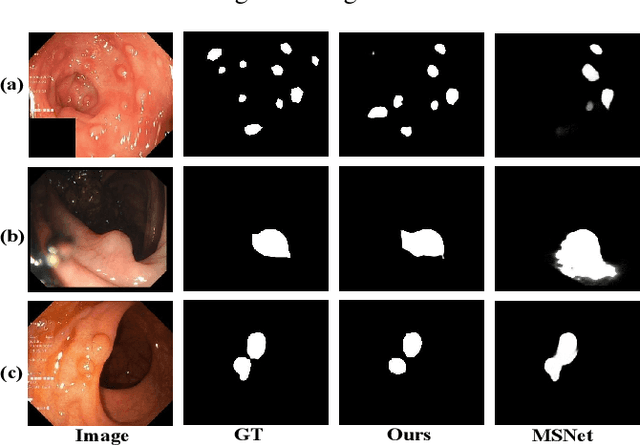
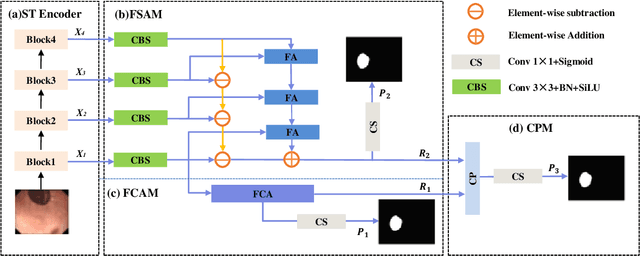

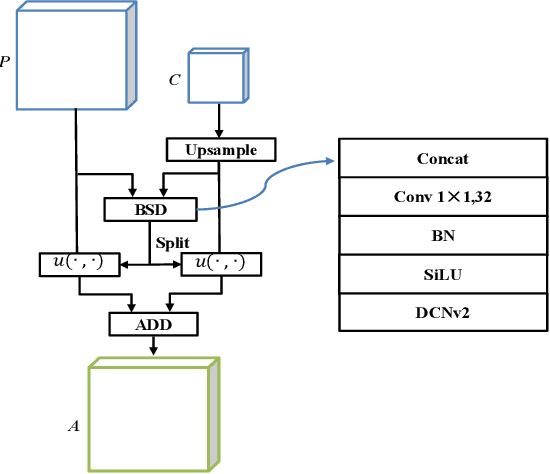
Abstract:Accurate segmentation of colorectal polyps in colonoscopy images is crucial for effective diagnosis and management of colorectal cancer (CRC). However, current deep learning-based methods primarily rely on fusing RGB information across multiple scales, leading to limitations in accurately identifying polyps due to restricted RGB domain information and challenges in feature misalignment during multi-scale aggregation. To address these limitations, we propose the Polyp Segmentation Network with Shunted Transformer (PSTNet), a novel approach that integrates both RGB and frequency domain cues present in the images. PSTNet comprises three key modules: the Frequency Characterization Attention Module (FCAM) for extracting frequency cues and capturing polyp characteristics, the Feature Supplementary Alignment Module (FSAM) for aligning semantic information and reducing misalignment noise, and the Cross Perception localization Module (CPM) for synergizing frequency cues with high-level semantics to achieve efficient polyp segmentation. Extensive experiments on challenging datasets demonstrate PSTNet's significant improvement in polyp segmentation accuracy across various metrics, consistently outperforming state-of-the-art methods. The integration of frequency domain cues and the novel architectural design of PSTNet contribute to advancing computer-assisted polyp segmentation, facilitating more accurate diagnosis and management of CRC.
Generalization Boosted Adapter for Open-Vocabulary Segmentation
Sep 13, 2024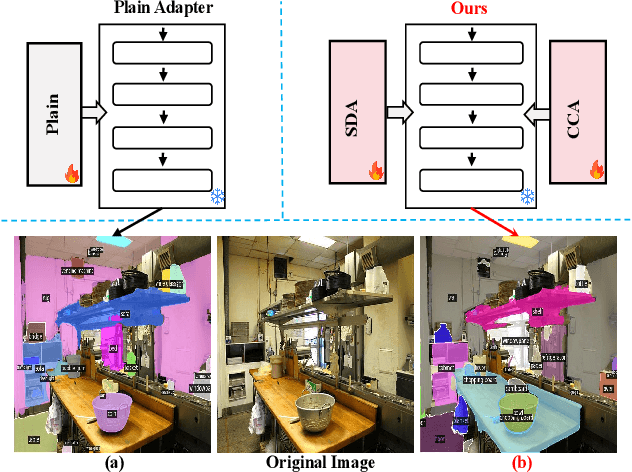
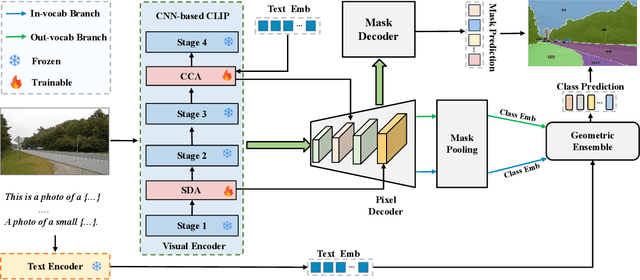
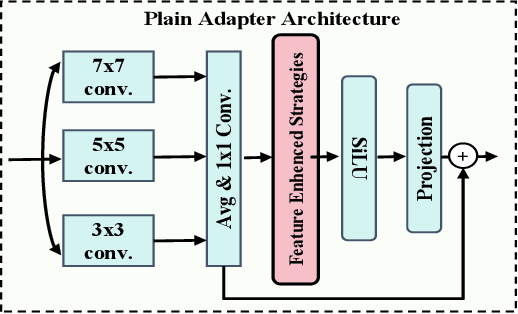
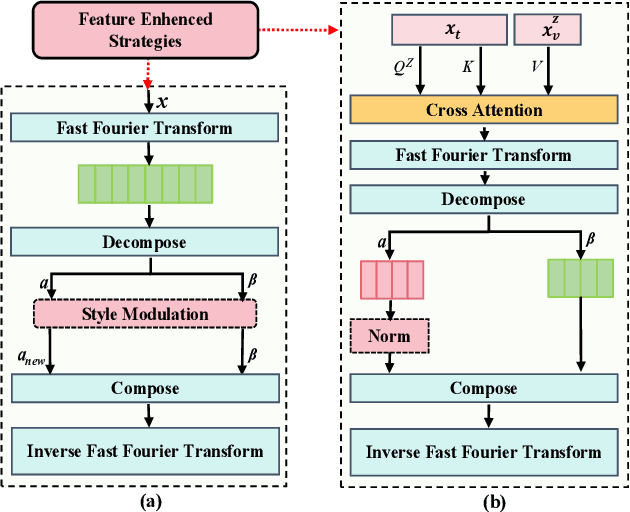
Abstract:Vision-language models (VLMs) have demonstrated remarkable open-vocabulary object recognition capabilities, motivating their adaptation for dense prediction tasks like segmentation. However, directly applying VLMs to such tasks remains challenging due to their lack of pixel-level granularity and the limited data available for fine-tuning, leading to overfitting and poor generalization. To address these limitations, we propose Generalization Boosted Adapter (GBA), a novel adapter strategy that enhances the generalization and robustness of VLMs for open-vocabulary segmentation. GBA comprises two core components: (1) a Style Diversification Adapter (SDA) that decouples features into amplitude and phase components, operating solely on the amplitude to enrich the feature space representation while preserving semantic consistency; and (2) a Correlation Constraint Adapter (CCA) that employs cross-attention to establish tighter semantic associations between text categories and target regions, suppressing irrelevant low-frequency ``noise'' information and avoiding erroneous associations. Through the synergistic effect of the shallow SDA and the deep CCA, GBA effectively alleviates overfitting issues and enhances the semantic relevance of feature representations. As a simple, efficient, and plug-and-play component, GBA can be flexibly integrated into various CLIP-based methods, demonstrating broad applicability and achieving state-of-the-art performance on multiple open-vocabulary segmentation benchmarks.
Beyond Local Views: Global State Inference with Diffusion Models for Cooperative Multi-Agent Reinforcement Learning
Aug 18, 2024



Abstract:In partially observable multi-agent systems, agents typically only have access to local observations. This severely hinders their ability to make precise decisions, particularly during decentralized execution. To alleviate this problem and inspired by image outpainting, we propose State Inference with Diffusion Models (SIDIFF), which uses diffusion models to reconstruct the original global state based solely on local observations. SIDIFF consists of a state generator and a state extractor, which allow agents to choose suitable actions by considering both the reconstructed global state and local observations. In addition, SIDIFF can be effortlessly incorporated into current multi-agent reinforcement learning algorithms to improve their performance. Finally, we evaluated SIDIFF on different experimental platforms, including Multi-Agent Battle City (MABC), a novel and flexible multi-agent reinforcement learning environment we developed. SIDIFF achieved desirable results and outperformed other popular algorithms.
 Add to Chrome
Add to Chrome Add to Firefox
Add to Firefox Add to Edge
Add to Edge